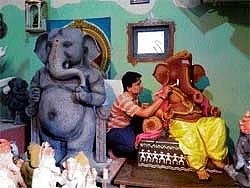

Tejas and Sourabh are proud that their Ganesha doesn’t inflict harm on nature. They learnt about the hazards of shining plaster-of-Paris idols in school, and since then, have convinced their parents to opt for eco-friendly Ganapa. As many as 12,000 households in Hubli and Dharwad contributed to the cause of eco-friendly Ganeshas last year.
It all started ten years back when Mukund Maigur, an environmental activist in Dharwad learnt about the health and environmental hazards of coating the idol with oil paints and also plaster-of-Paris, the non-degradable material used. After using a mud idol himself, he decided to take up the cause through his organisation Kriyasheela Geleyara Balaga.
During one such awareness camp, he met Manjunath Hiremath, an idol maker
Manjunath did not have any formal training. A keen observer, he took to making idols as a profession after his Pre-University. Today, he is one of the very few artistes who makes Ganesha idols of mud. He uses a unique technique while designing the idol which reduces the soil consumption by seventy per cent and cost of production by fifteen per cent.
This design where the idol is hollow, demands time, expertise and skill. Manjunath uses computer graphics to get the proportions right. This design makes the idol strong, but light in terms of weight.
Manjunath attended an awareness workshop organised by Mukund Maigur where he realised the negative impact of oil paints used for the idols. He realised that artists are invariably first in the line of fire through direct consumption of lead, arsenic and other hazardous heavy metals. From the next season he decided to take up the issue with his customers, and spread awareness.
It was not an easy task to convince those who are used to bright-coloured idols. There were few takers. However, in association with Maigur, he explained to customers issues such as pollution of water bodies, health hazards, and global warming. He firmly believes that the deity of Ganesha represents nature and the ‘Mruthika Ganesha’ is the best idol to be worshipped.
Importance of natural colours
Mukund Maigur also organised a three-day workshop a couple of years ago to educate artistes about natural colours that could be used and the process involved. Regional Design and Technical Development Centre, Bangalore guided the artistes in extracting, mixing and applying eco-friendly colours. “Such exposure is very important for us, artistes. We can then create awareness among buyers,” says Manjunath.
Manjunath’s entire family is involved in the profession. His wife Nirmala learnt the basics from her husband. His children too have shown interest in the art. The couple works all year round, and their work typically starts a month after Ganesha Chaturthi, when they go about making idols for the next year.
This year, they have made 250 idols for homes and 52 for public festivities. Sizes range from one foot to ten feet. Some are non-coloured, while some are coated with sandal paste. For other idols, they have used natural ingredients like red soil, sandalwood, turmeric, coal, limestone, ashtagandha and gopichanda.
Setting a trend
“People feel that oil-painted idols are outdated,” says Nirmala. At least 500 enthusiasts visit Manjunath Hiremath’s idol workshop every year ahead of Ganesha Chaturthi. Using oil paint becomes inevitable for some idols; this year such idols have not crossed five. As far as possible, he tries to avoid such situations by using a shining cloth instead of paint.
Water colours which have a mild composition, though slightly expensive, are also used. A 1.5-ft tall Ganesha which is eco-friendly costs Rs 500, about Rs 150 more than the plaster-of-Paris Ganesha.
But, there are people willing to spend a little more. Take Jagadishvara Salimath, an employee of the Water Board, for instance. He feels that spending a little more is worth, when we consider its advantages.
“Idols with a message” is a distinct idea that Manjunath has carried forward. Idols that match slogans like ‘Save the environment’ have made him popular among Public Ganesha Festival Committees. To illustrate that fertile soil is used for making idols and that it is the responsibility of worshippers to give back to nature, he once sowed ragi on one of the idols, which sprouted beautifully.
He is aware of the fact that becoming a dealer of plaster-of-Paris Ganesha idols is easy and fetches more income. But his conscience doesn’t let him take this short-cut route. According to Manjunath, dealers, some of whom are artistes, make good money during the festival. They opt for it because it is easy and has a shimmering effect. Manjunath is associated with like-minded artistes like Pranesh Kadaramandalagi, Kamble and Harapanahalli, who make idols without the use of colours.
Explains Mukund Maigur, “In a consumerist society, where we get anything we wish for, that very moment, people tend not to plan. They purchase idols on the morning of the festival, and the bright plaster-of-Paris Ganeshas are conspicuously present in the market. The brighter, the more harmful, because dark colours like blue and red have high lead and arsenic content.
Artistes who make eco-friendly Ganesha cannot afford to make idols without prior orders, and organise a sale. A majority of people, 80 per cent of the City, worships idols made of artificial materials. We also find certain institutions like Water Board which have set an example.
Public Ganeshotsva Committees also seem to have taken up the issue seriously. Of the 300-plus idols worshipped by these committees last year, at least a hundred were nature-friendly. This year, I see a considerable increase in the interest of people towards eco-friendly Ganesha.”
